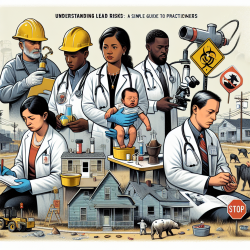Introduction
In the world of special education, understanding the various factors that impact a child's development is crucial. A recent study titled "Neighborhood Poverty in Combination with Older Housing Is Associated with Adverse Birth Outcomes: A Study on Ubiquitous Lead Risk among 1 Million Births in Texas" sheds light on the significant influence of environmental factors, particularly lead exposure, on birth outcomes. This blog aims to provide practitioners with insights from this study and encourage further research and implementation of its findings.
The Study's Key Findings
The study explored the correlation between neighborhood poverty, housing age, and adverse birth outcomes in Texas. It revealed that mothers living in high-poverty neighborhoods with older housing were at a significantly higher risk of adverse birth outcomes, such as preterm birth, low birth weight, and small-for-gestational age.
Here are some key points from the study:
- Neighborhoods with housing built before the lead-based paint ban and high poverty levels pose a higher risk for lead exposure.
- Lead exposure is linked to several adverse birth outcomes, including preterm labor and low birth weight.
- High-poverty neighborhoods with older housing are often concentrated in urban areas.
- Racial and ethnic disparities exist, with U.S.-born Black and Hispanic mothers facing higher risks compared to their White counterparts.
Implications for Practitioners
For practitioners in the field of special education, these findings highlight the importance of considering environmental factors when assessing and planning interventions for children. Here are some steps you can take:
- Raise Awareness: Educate parents and communities about the risks associated with lead exposure, particularly in older, high-poverty neighborhoods.
- Advocate for Testing: Encourage lead testing in homes, especially those built before 1975, to identify and mitigate risks early.
- Collaborate with Public Health Agencies: Work with local health departments to support initiatives aimed at reducing lead exposure in high-risk areas.
- Support Place-Based Interventions: Advocate for federal and state funding to implement interventions that address environmental hazards in at-risk neighborhoods.
Encouraging Further Research
While the study provides valuable insights, it also opens the door for further research. Practitioners can contribute by:
- Conducting Local Studies: Investigate the prevalence of lead exposure and its impact on birth outcomes in your community.
- Exploring Other Environmental Factors: Consider how other pollutants and socio-economic factors might interact with lead exposure to affect child development.
- Sharing Findings: Publish your research in journals and present at conferences to inform and influence policy decisions.
Conclusion
The study on lead exposure and adverse birth outcomes in Texas provides crucial insights for practitioners in special education. By understanding and addressing the environmental factors that impact child development, we can improve outcomes for children in at-risk communities. To read the original research paper, please follow this link: Neighborhood Poverty in Combination with Older Housing Is Associated with Adverse Birth Outcomes: A Study on Ubiquitous Lead Risk among 1 Million Births in Texas.










